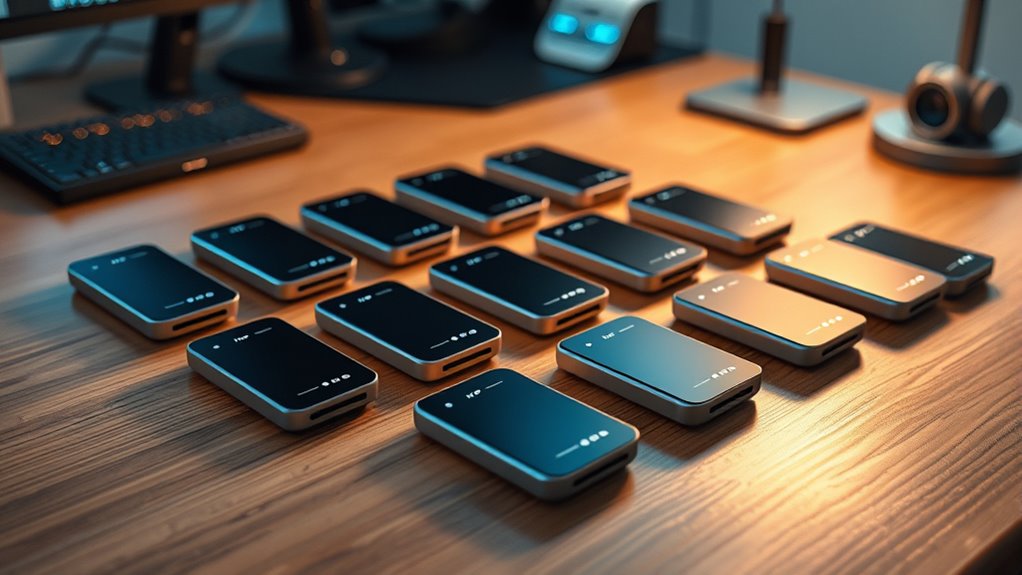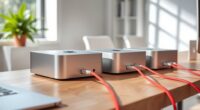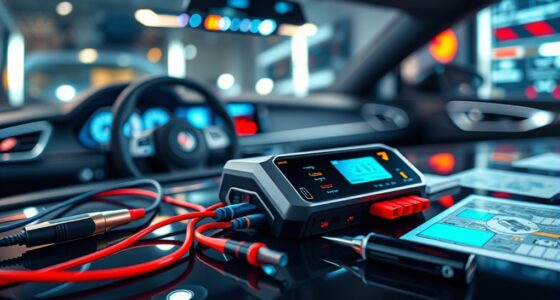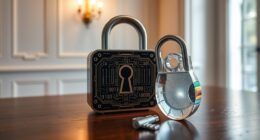If you’re looking to simplify your contactless transactions in 2025, there are plenty of NFC reader writers that fit various needs. I’ve found options supporting multiple standards, like Mifare and ISO, with features like plug-and-play interfaces, portable designs, and security options like encryption. Whether for access control, cloning, or secure transactions, these devices can handle a broad range of cards and tags. Stay with me, and I’ll give you a detailed guide to the best choices for your projects.
Key Takeaways
- A comprehensive overview of top NFC reader/writers offering compatibility with various standards and frequencies for diverse contactless applications.
- Detailed features like user-friendly interfaces, portability, and software support to facilitate easy setup and operation.
- Insights into card cloning, emulation, and security capabilities to meet different contactless security and management needs.
- Identification of limitations, troubleshooting tips, and considerations for ensuring reliable performance across devices.
- Factors such as transfer speeds, security enhancements, and device selection criteria to optimize contactless solutions in 2025.
ACS ACR122U NFC Reader Writer + 5 PCS Ntag213 NFC Tag + Free Software
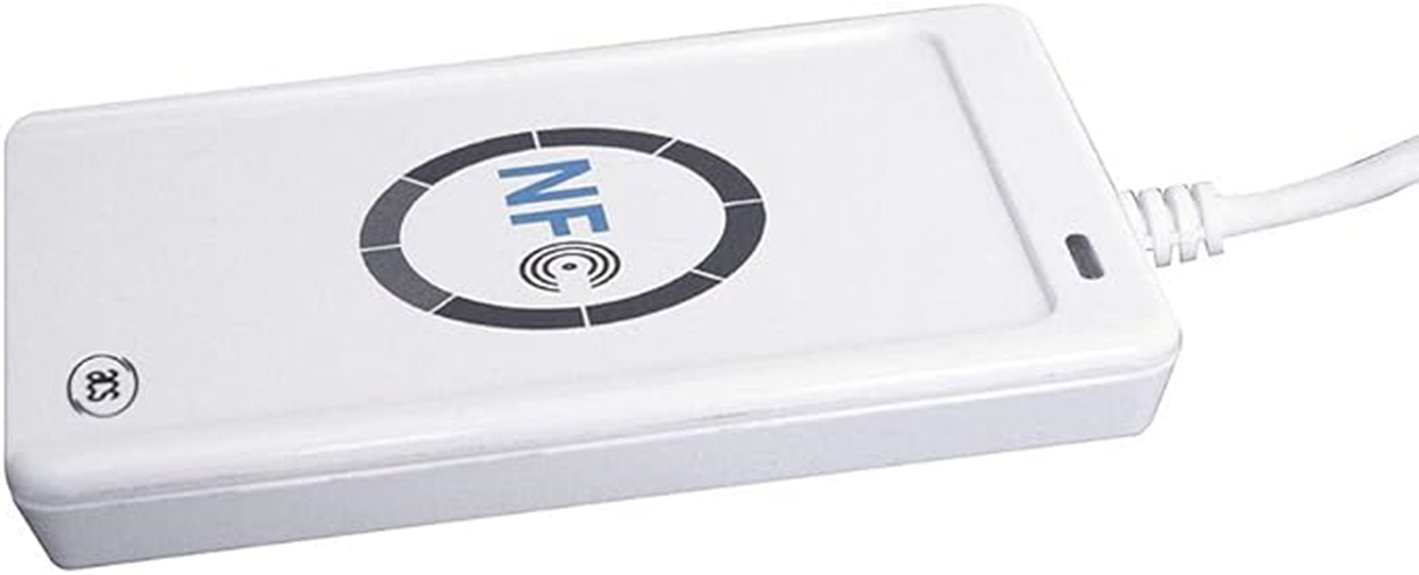
If you’re looking for a reliable, easy-to-use NFC reader writer that supports a wide range of contactless applications, the ACS ACR122U NFC Reader Writer is an excellent choice. It comes with five Ntag213 NFC tags and free software, making setup straightforward. Supporting 13.56 MHz frequency and compatible with standards like Mifare and ISO14443A, it handles access control, data exchange, and more. The device simplifies reading and writing NFC tags, ideal for both beginners and professionals. Plus, the included SDK and software make integration into various projects seamless, ensuring you can quickly start using it for your contactless needs in 2025.
Best For: individuals or businesses seeking an easy-to-use NFC solution for access control, data exchange, and contactless applications, suitable for both beginners and professionals.
Pros:
- Supports multiple NFC standards including Mifare, Ntag213, and ISO14443A for versatile compatibility
- Comes with free software and SDK for seamless integration and easy operation
- Includes multiple NFC tags and cards, making it ready for various contactless applications
Cons:
- May require some technical knowledge for advanced integration
- Limited to 13.56 MHz frequency, not compatible with other RFID frequencies
- Software and SDK availability might depend on ongoing support from the manufacturer
NFC ACR122U Contactless IC Card Reader Writer/USB + SDK + IC Card
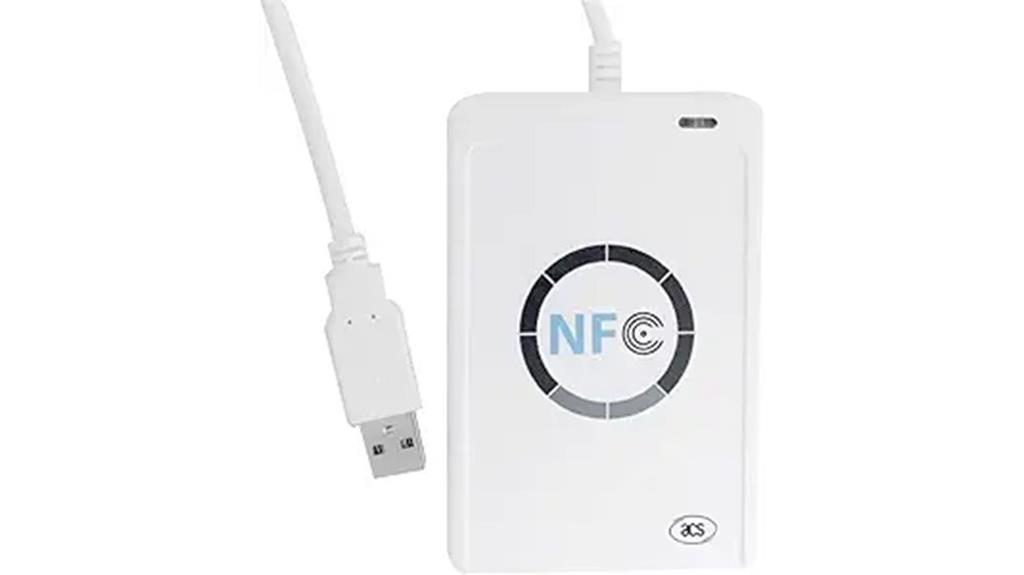
The NFC ACR122U Contactless IC Card Reader/Writer stands out as an ideal choice for users seeking a versatile and reliable device for secure identity verification and contactless transactions. It supports Mifare, ISO 14443, NFC, and FeliCa technologies, making it suitable for access control, electronic payments, and logistics. With fast read/write speeds up to 242 kbps and compatibility with Windows, Linux, and legacy systems, it’s easy to set up. The device includes software, test cards, and a secure SAM slot for added protection. While it’s a cost-effective solution, some users report outdated drivers and limited support, reflecting its age but still offering practical functionality.
Best For: users seeking a cost-effective, versatile NFC reader for access control, electronic payments, and identity verification across various operating systems.
Pros:
- Supports multiple contactless technologies including Mifare, ISO 14443, NFC, and FeliCa for broad compatibility.
- Easy to set up with plug-and-play USB connection and included software tools.
- Compact, lightweight design suitable for diverse applications like security and logistics.
Cons:
- Outdated drivers and limited software updates may cause compatibility issues with newer systems.
- Customer reviews indicate occasional difficulties with writing and software reliability.
- Support and firmware updates are limited due to the device’s age, potentially restricting advanced features.
ACR1252U USB NFC Reader III
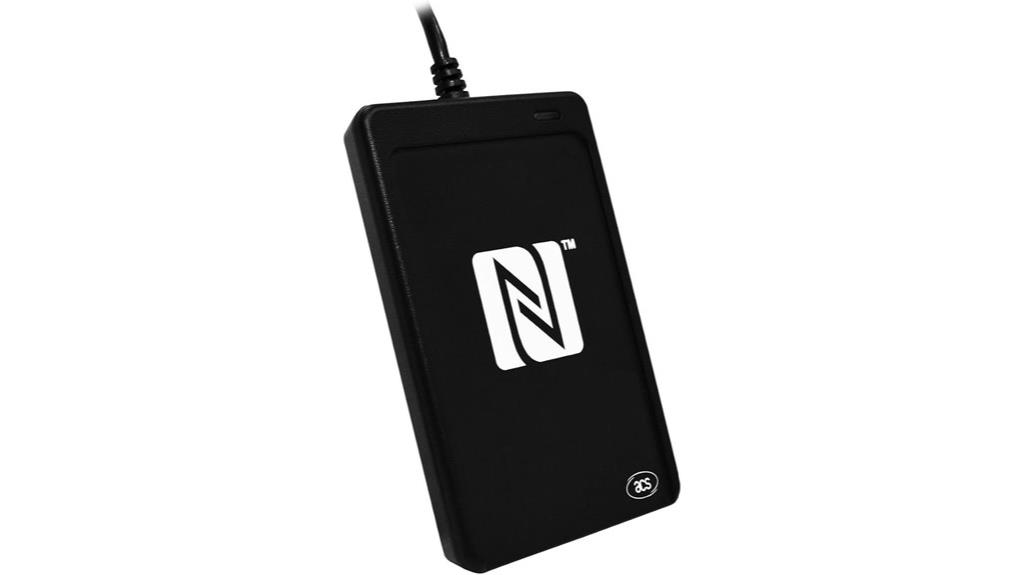
For anyone seeking a reliable NFC reader with broad compatibility, the ACR1252U USB NFC Reader III stands out thanks to its NFC Forum certification and support for multiple contactless standards. Its compact design fits easily on any desk, and it’s plug-and-play via USB 2.0, making setup straightforward. Supporting ISO 14443, MIFARE, FeliCa, and NFC types, it handles various contactless cards and tags efficiently. Features like a secure SAM slot, anti-collision, and high-speed read/write up to 424 kbps ensure secure, reliable transactions. Compatible with Windows, Linux, and Mac, it’s versatile for access control, payments, and testing, earning high user praise.
Best For: individuals and organizations seeking a versatile, secure, and easy-to-use NFC reader compatible with multiple contactless standards and operating systems.
Pros:
- NFC Forum-certified for broad interoperability and reliable performance
- Supports multiple contactless technologies including ISO 14443, MIFARE, and FeliCa
- Plug-and-play with USB 2.0, compatible with Windows, Linux, and Mac
Cons:
- Initial setup may require downloading drivers from the manufacturer’s website
- Minimal packaging without a manual, which may challenge first-time users
- Limited documentation included; users may need to rely on online resources
NFC Reader ACR122U USB Contactless Smart Card Reader Writer
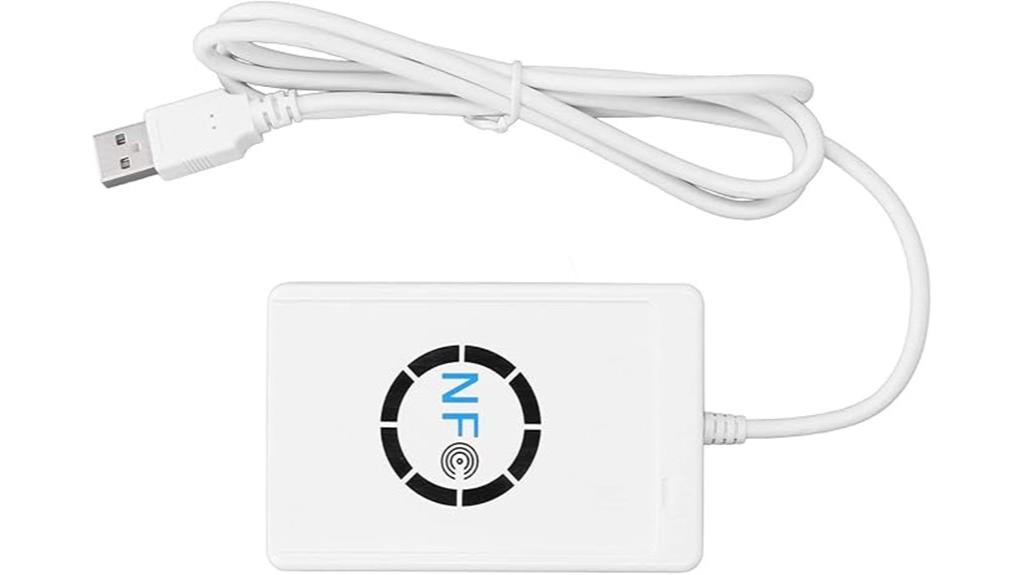
The NFC Reader ACR122U USB Contactless Smart Card Reader Writer stands out as an ideal choice for professionals seeking reliable and versatile contactless solutions. Its USB 2.0 interface delivers fast data transfer at 424kbps, operating at 13.56MHz and supporting ISO 14443 types A and B. With a built-in antenna, it reads tags up to 50mm away and features anti-collision technology for handling multiple cards. Compact and lightweight, it’s easy to use across various operating systems, making it perfect for security, access control, and data management tasks. Its plug-and-play setup ensures efficiency, while its broad compatibility and support make it a dependable tool for contactless smart card needs.
Best For: professionals and organizations seeking a reliable, versatile contactless smart card reader for security, access control, and data management tasks.
Pros:
- Supports multiple NFC tags and ISO 14443 types A and B for broad compatibility
- Fast data transfer rate of 424kbps with stable contactless reading up to 50mm
- Compact, lightweight design with plug-and-play operation across various operating systems
Cons:
- May require dummy APDU commands to access certain NFC tags like Ultralight C and SL1
- Limited to 13.56MHz frequency, not suitable for other RFID frequencies
- Reading distance depends on tag type and environmental factors, potentially limiting range
JASAG Smart Access Control Copier with RFID and NFC
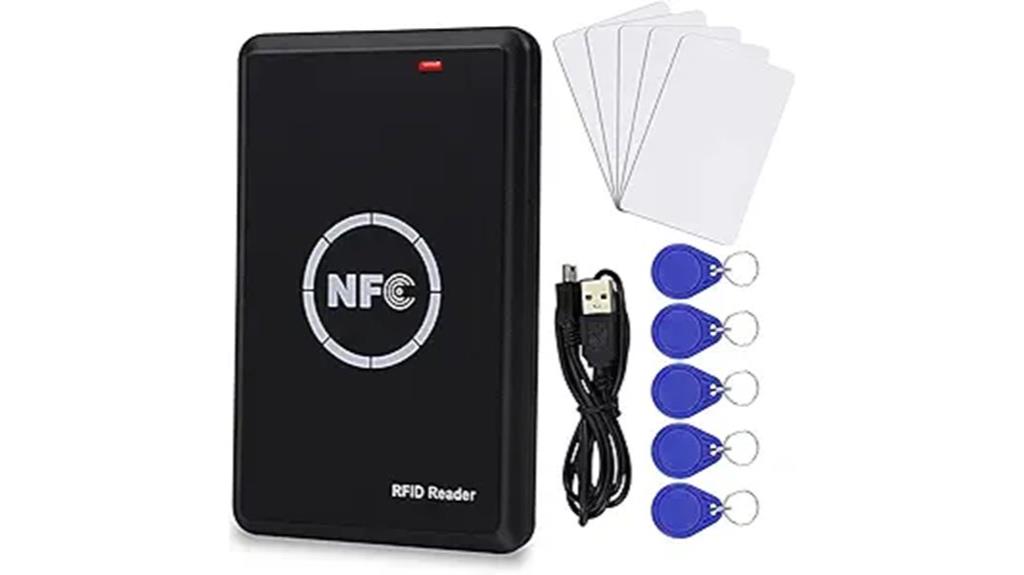
If you’re looking to duplicate RFID and NFC cards across dual frequencies—125KHz and 13.56MHz—the JASAG Smart Access Control Copier stands out as a practical option. It supports copying ID125KHz, 8800, 5200, and other cards, including UID and encryption types. The device is compatible with all major operating systems and features a USB interface with no driver needed. It comes with software for copying and a set of five white T5577 cards and blue key fobs. However, its reliability varies, and it doesn’t support HID cards or some system-specific formats. Users report inconsistent performance, so verify your card compatibility before purchasing.
Best For: individuals or businesses needing an affordable and versatile RFID/NFC card copier for access control and basic cloning tasks across multiple operating systems.
Pros:
- Supports dual frequencies (125KHz and 13.56MHz) for a range of card types.
- No driver installation required, with software preloaded on a USB disk for easy setup.
- Compatible with all major operating systems including Windows, Mac, and Linux.
Cons:
- Inconsistent performance with some RFID/NFC cards, especially HID and certain encrypted cards.
- Limited encoding and advanced features, with some users experiencing unreliable copying.
- Compatibility issues with USB-C ports and some card formats, which can hinder proper functionality.
X7 NFC RFID Card Copier Reader Writer Duplicator (4 pcs UID Keyfobs & 5 pcs 5577 Keyfobs)
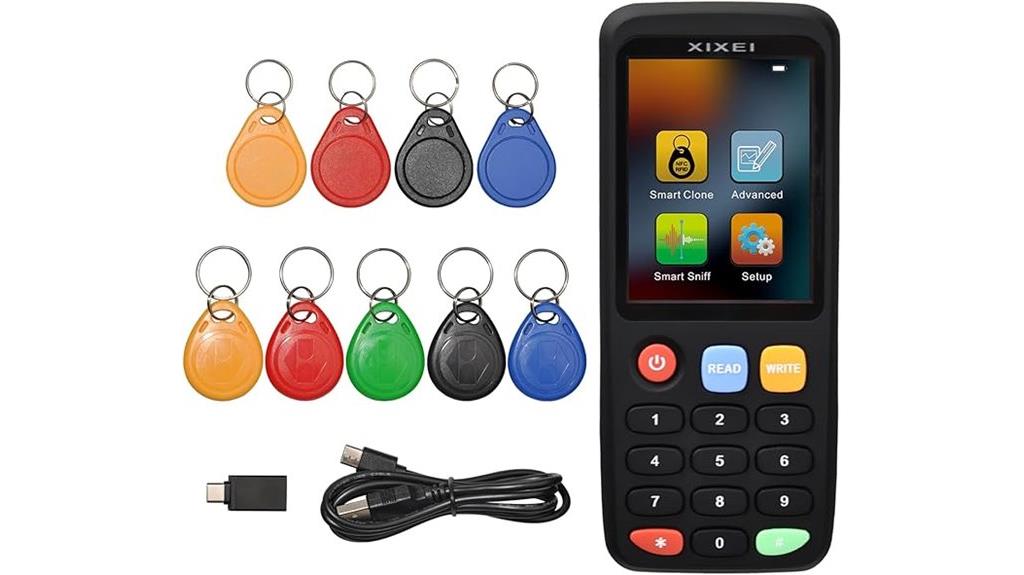
When seeking a versatile RFID cloning device suitable for basic card duplication, the X7 NFC RFID Card Copier Reader Writer Duplicator stands out with its support for multiple frequencies and user-friendly features. I appreciate its ability to read and write across 125KHz to 13.56MHz, making it compatible with various RFID cards. The 2.8-inch TFT screen displays info clearly, and inputting card numbers via keypad is quick and simple. Its rechargeable battery adds convenience, eliminating the need for replacements. While it handles UID and 5577 keyfobs effectively, it’s mainly suited for basic cards and may struggle with encrypted, high-security fobs. Overall, it’s a handy tool for straightforward cloning tasks.
Best For: users needing a versatile, easy-to-use RFID cloning device for basic cards across multiple frequencies, suitable for non-secure, older RFID tags and keyfobs.
Pros:
- Supports multiple frequencies (125KHz to 13.56MHz), ensuring compatibility with various RFID cards and keyfobs.
- Features a user-friendly 2.8-inch TFT color screen and keypad for quick operation and easy programming.
- Equipped with a rechargeable battery, eliminating the need for frequent replacements and enhancing portability.
Cons:
- Limited capability with encrypted or high-security RFID cards, which it often cannot read or duplicate.
- Connectivity and software compatibility issues, such as requiring antivirus disablement and limited support for newer cards.
- Mixed user reviews regarding reliability, with some experiencing failure to read certain fobs and difficulties with non-functioning units.
ACS ACR1552U USB-C NFC Reader IV

For anyone seeking a reliable, plug-and-play NFC reader with broad compatibility, the ACS ACR1552U USB-C NFC Reader IV stands out as a top choice. It’s CCID and PC/SC compliant, supporting 13.56MHz contactless cards like MIFARE, FeliCa, and ISO 14443 types A and B. Its USB-C connection makes setup quick, with no driver installation needed on Windows 10. The device supports fast data transfer up to 848 kbps and includes a Secure Access Module slot for enhanced security. Compact and lightweight at just over 3.5 ounces, it offers versatile modes like card emulation and keyboard emulation, making it suitable for various contactless applications.
Best For: professionals and organizations seeking a reliable, plug-and-play NFC reader compatible with a wide range of contactless cards and built-in security features.
Pros:
- Supports multiple contactless card types including MIFARE, FeliCa, and ISO 14443 A/B, ensuring broad compatibility.
- USB-C connection allows for quick, driver-free setup on Windows 10 devices.
- Includes a Secure Access Module slot for enhanced transaction security through key diversification and mutual authentication.
Cons:
- Customer ratings are moderate at 3.8 out of 5 stars, indicating potential variability in user experience.
- Limited information on compatibility with operating systems beyond Windows 10.
- Availability and pricing may vary, and some users might encounter restocking fees or support limitations from marketplace vendors.
Teyleten Robot PN532 V2.0 RFID NFC Wireless Module PCB Attenna Reader Writer
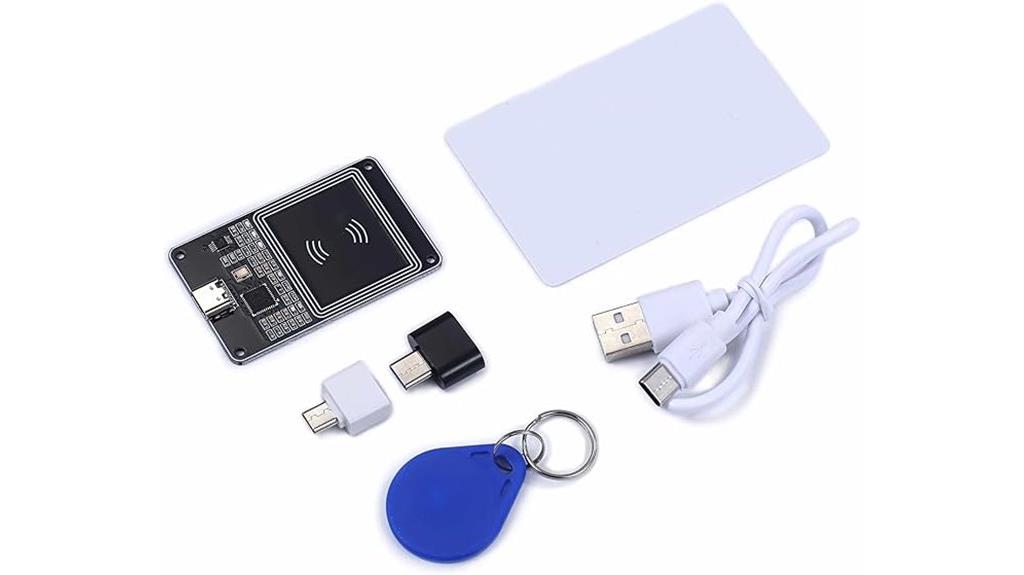
The Teyleten Robot PN532 V2.0 RFID NFC Wireless Module stands out for its versatility, supporting multiple communication protocols like I2C, SPI, and HSU, making it an ideal choice for users needing flexible integration options. Its compact design weighs just 1.76 ounces, with dimensions of 5.67 x 3.62 x 0.91 inches. Compatible with Windows 7/10 (64-bit), it’s suited for RFID and NFC applications such as access control and electric vehicle cards. While it mainly supports S50 cards, compatibility with Android phones via OTG is over 98%. However, it has limitations with ID cards and certain third-party cards, often requiring additional hardware or drivers.
Best For: users seeking a versatile and compact RFID/NFC module compatible with multiple communication protocols for access control, vehicle NFC, and embedded applications.
Pros:
- Supports multiple communication protocols including I2C, SPI, and HSU for flexible integration
- Compact and lightweight design measuring just 5.67 x 3.62 x 0.91 inches and weighing 1.76 ounces
- High compatibility with Windows 7/10 (64-bit) and Android phones with OTG, supporting over 98% success rate for NFC simulation
Cons:
- Limited support for ID cards and certain third-party cards without additional hardware or drivers
- Compatibility issues with included cards and tags, often requiring extra configuration or hardware adjustments
- Performance largely dependent on hardware setup, which may be finicky or require troubleshooting for optimal operation
LEXI RFID NFC Duplicator and Programmer
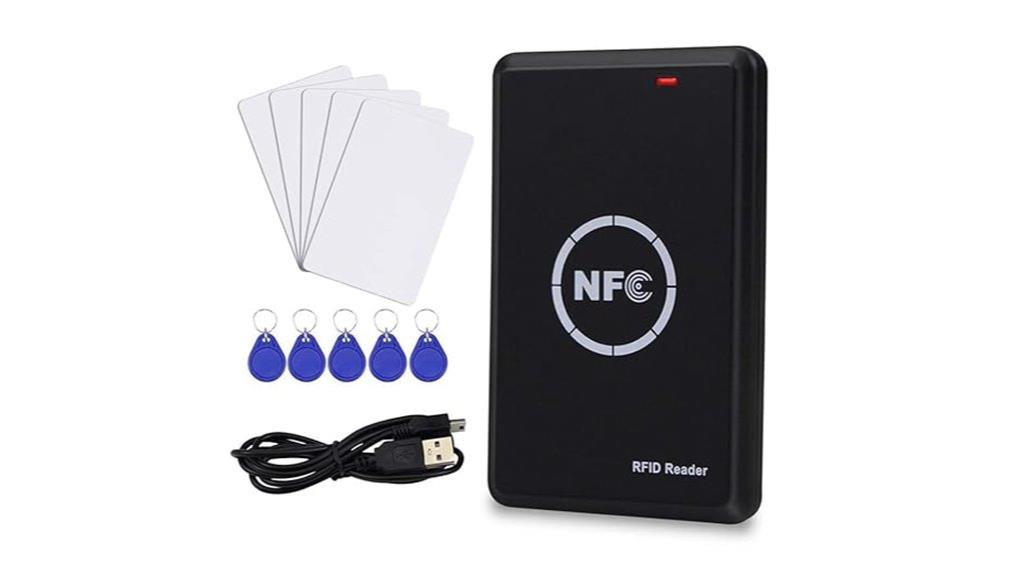
If you’re looking for a compact and lightweight RFID duplicator, the LEXI RFID NFC Duplicator and Programmer stands out with its dual-frequency support for 125KHz and 13.56 MHz cards. It features a sturdy ABS shell, LED indicators, and a buzzer for easy operation. The device offers fast card reading and supports programming UID/T5577 writable and encrypted smart cards via USB. However, users often face issues with software detection, compatibility, and reliability. The software is hard to find, unreliable, and sometimes unsafe, leading to frustration. Overall, it’s a basic device that struggles with consistent performance and lacks extensive support.
Best For: hobbyists or enthusiasts willing to troubleshoot and work around software and hardware limitations to experiment with RFID duplication on outdated or compatible systems.
Pros:
- Supports dual-frequency operation at 125KHz and 13.56 MHz for versatile card reading.
- Compact and lightweight design with ABS shell and LED indicators for basic usability.
- Capable of programming UID/T5577 writable and encrypted smart cards via USB connection.
Cons:
- Frequently faces issues with software detection, compatibility, and unreliable operation.
- Software is difficult to find, often unsafe, and requires outdated systems to run properly.
- Overall build quality, stability, and customer support are poor, leading to frustration and limited functionality.
USB NFC Card Reader Writer Copier for ISO 14443 Tags
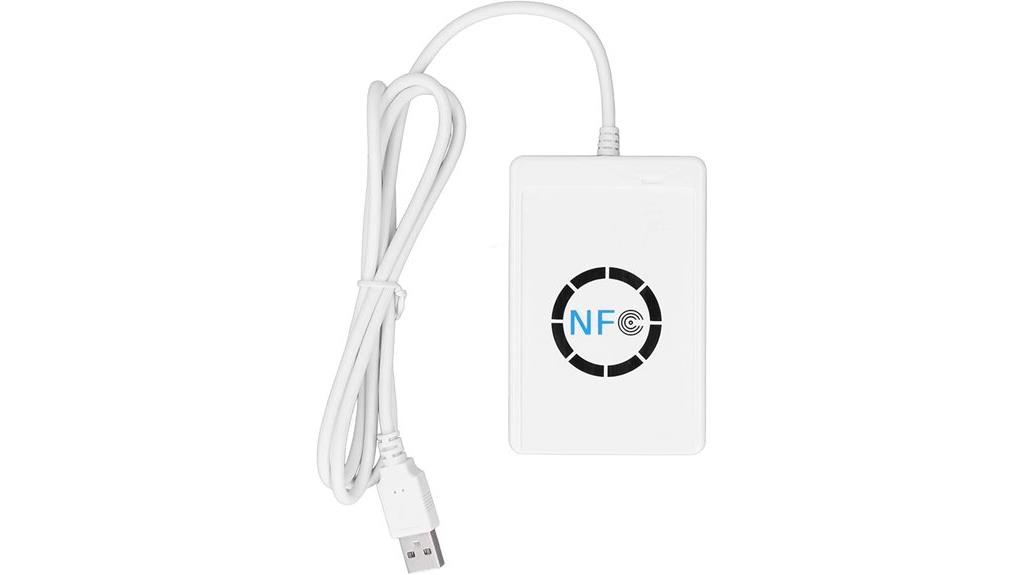
A USB NFC Card Reader Writer Copier for ISO 14443 Tags is ideal for those who need a reliable, portable device for NFC tag programming and data transfer. It operates at 13.56MHz and supports all four NFC tag types within ISO 14443 A and B standards. With a plug-and-play USB 2.0 interface, it offers read/write speeds up to 424kbps and a stable contactless range of up to 50mm. Designed for NFC duplication, batch chip making, and data transfer, it’s compact and lightweight. However, it requires some technical knowledge, and compatibility issues may arise on certain computers due to driver limitations.
Best For: tech-savvy professionals and hobbyists needing a portable, reliable NFC reader/writer for ISO 14443 tags who are comfortable with technical setup and software configuration.
Pros:
- Supports all four NFC tag types within ISO 14443 A and B standards, providing versatile compatibility.
- Compact, lightweight design with a stable contactless reading distance of up to 50mm for portability.
- USB 2.0 plug-and-play interface offers straightforward operation with read/write speeds up to 424kbps.
Cons:
- No included software or drivers, requiring user technical knowledge for setup and operation.
- Compatibility issues may occur on some computers due to driver limitations, restricting functionality.
- Does not support Type 5 NFC tags and may present challenges for users unfamiliar with NFC programming.
RFID Reader Writer X100 for Access Control System
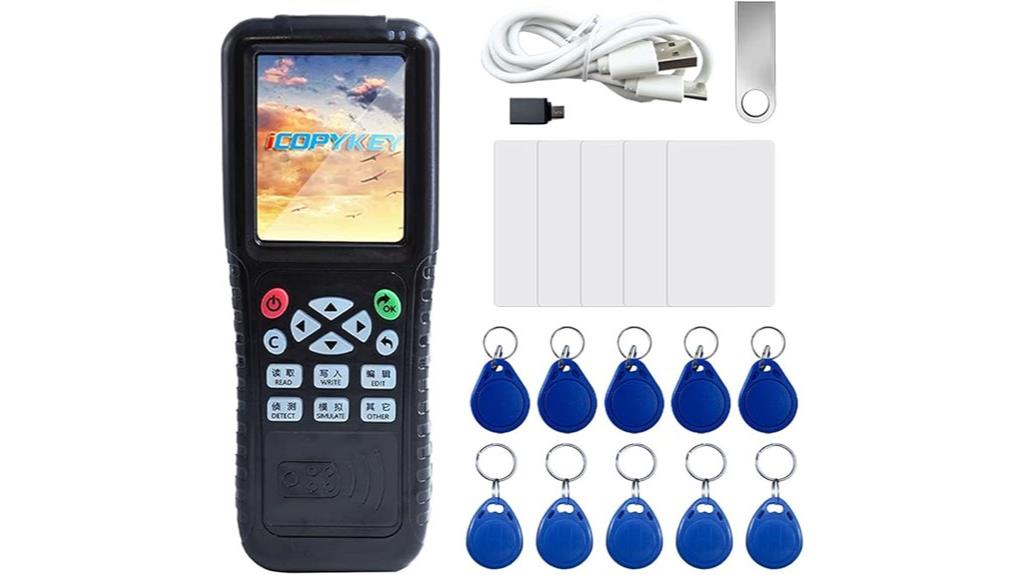
Designed specifically for access control systems, RFID Reader Writer X100 stands out with its multi-frequency compatibility and extensive card support, making it ideal for security applications requiring versatile card reading, writing, and cloning. It supports frequencies from 125KHz to 13.56MHz and can identify and copy cards like S50, HID, TK4100, and more. The device reads, writes, and clones encrypted IC cards, with an NFC simulation feature for emulating cards with a single button. Its 2.8-inch TFT screen offers easy navigation, and app integration allows for data management via Windows or Android. Simple to use, it’s a powerful tool for enhancing access control security.
Best For: security professionals and access control system integrators seeking a versatile RFID reader/writer with multi-frequency support, cloning capabilities, and easy data management.
Pros:
- Supports multiple frequencies and a wide range of card types for versatile application.
- Includes NFC simulation and cloning features, enhancing security and convenience.
- Equipped with a user-friendly 2.8-inch TFT screen and app integration for easy operation and data management.
Cons:
- Not compatible with Mac systems; Windows and Android only.
- Default language is Chinese, requiring manual setting to English for non-Chinese users.
- Possible malware detection issues on Windows if not configured properly or if malware protection is not disabled.
RFID ID Copier and Writer for NFC and 125kHz Cards
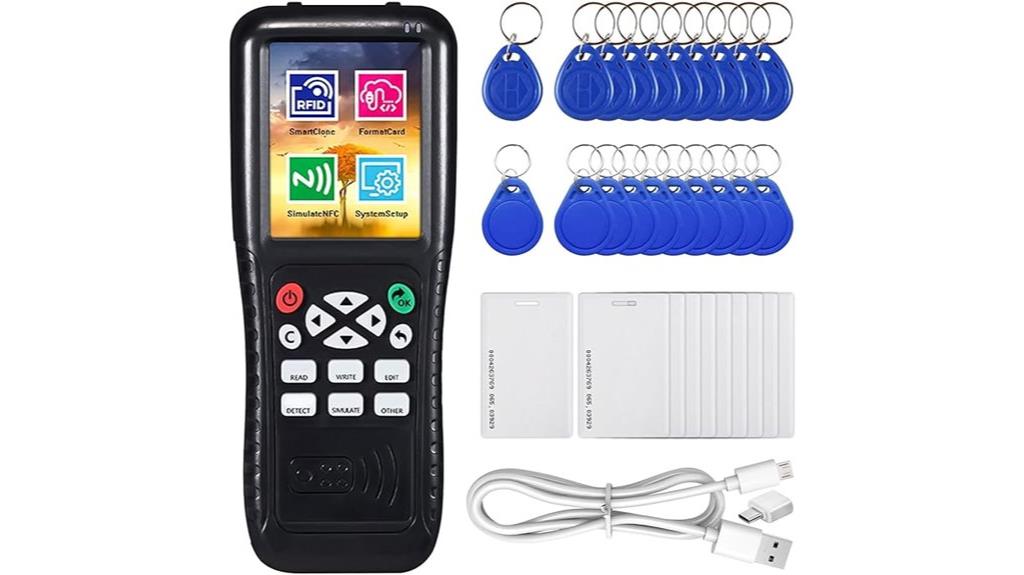
The RFID ID Copier and Writer for NFC and 125kHz Cards stands out for its broad compatibility with various card types and frequencies, making it ideal for users who need to duplicate or program multiple RFID and NFC devices. It supports RFID and NFC cards, key fobs, and tags across frequencies like 125kHz, 175kHz, and 13.56MHz, though it’s limited to non-secured cards such as UID, FUID, and T5577. Compatible with most writable blank cards, it requires a Windows PC and offers decoding capabilities for certain encrypted cards via specialized software. While it’s useful for copying common RFID devices, it has limitations with secured or encrypted cards and lacks a keypad for editing.
Best For: users who need to duplicate or program a variety of RFID and NFC cards and fobs across multiple frequencies on a Windows PC, especially those working with non-secured, writable cards.
Pros:
- Supports a wide range of frequencies and common writable card types for versatile use.
- Capable of decoding certain encrypted cards through specialized software, beneficial for advanced users.
- Compact design with easy connectivity to Windows PCs, making it portable and straightforward to operate.
Cons:
- Cannot read or write secured or encrypted RFID cards like MF1 S50, EM4100, or TK4100.
- Lacks a keypad or direct editing interface, limiting on-device customization.
- Requires additional software for decoding encrypted cards and is incompatible with macOS systems.
Nintendo NFC Reader/Writer Accessory – Nintendo 3DS
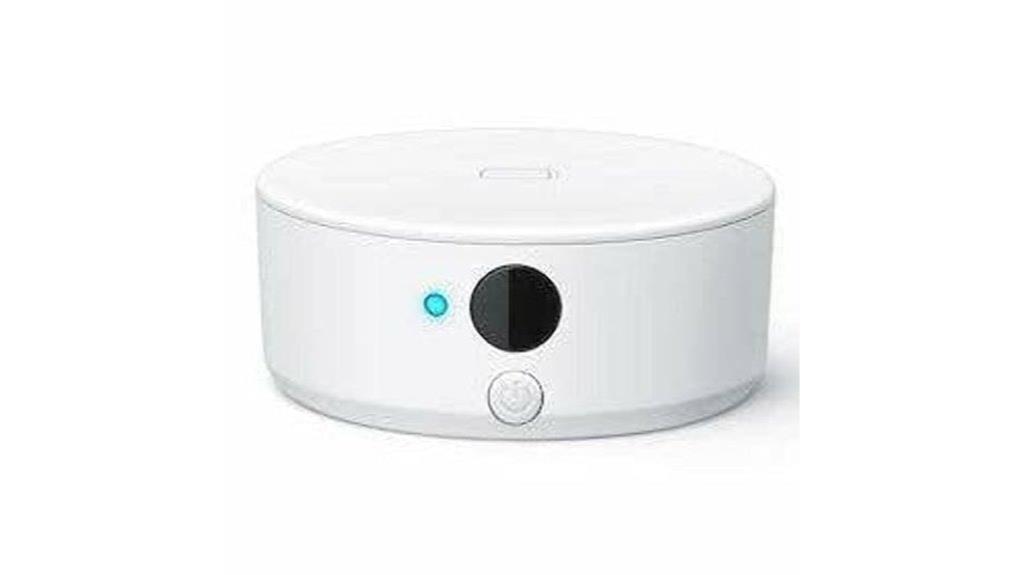
If you’re looking to enhance your Nintendo 3DS experience with amiibo functionality, the Nintendo NFC Reader/Writer accessory is an essential tool. It enables compatible systems like the original 3DS, 3DS XL, and 2DS to read and write amiibo data. The accessory is sold separately and allows you to tap amiibo figures to access game bonuses, content, or features. For the New Nintendo 3DS XL, built-in NFC handles amiibo interactions directly. You can also connect the accessory to a Wii U GamePad for additional benefits. Overall, this accessory simplifies amiibo management and expands your gameplay options across Nintendo devices.
Best For: gamers who want to expand their amiibo collection capabilities and unlock additional content across Nintendo 3DS and Wii U systems.
Pros:
- Compatible with multiple Nintendo 3DS family systems including 3DS, 3DS XL, and 2DS
- Enables access to exclusive game bonuses and content via amiibo tapping
- Easy to use with a simple tap to NFC reader or built-in NFC on New Nintendo 3DS XL
Cons:
- Sold separately; not included with Nintendo 3DS systems
- Requires additional amiibo figures to fully utilize the functionality
- Limited to Nintendo devices with NFC support, restricting use on non-compatible consoles
RFID Copier 125kHz RFID Reader Writer Handheld ID Copier
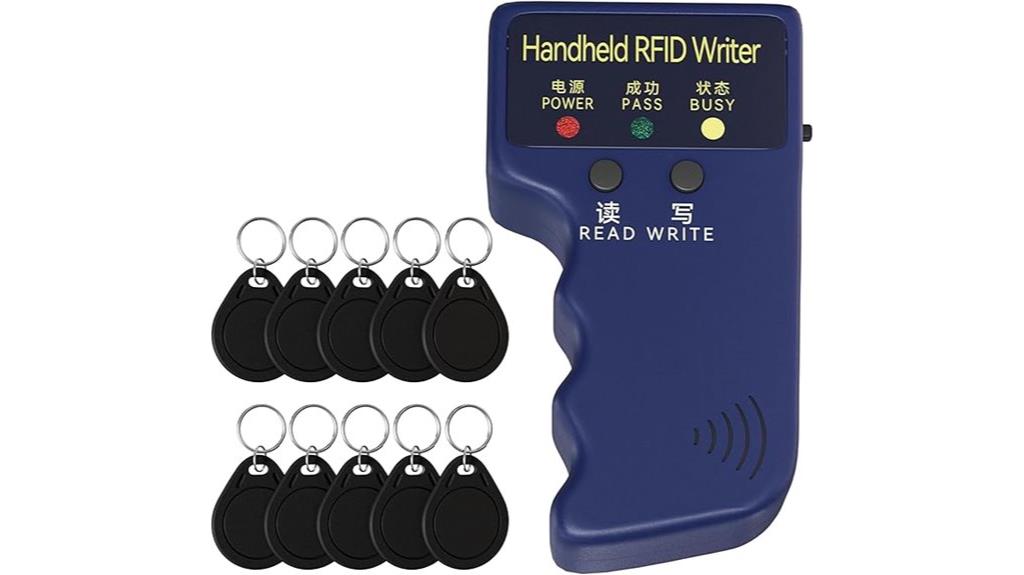
For those seeking a straightforward and portable solution to duplicate RFID cards, the RFID Copier 125kHz RFID Reader Writer Handheld ID Copier stands out. It includes a handheld device and 10 blank T5577 keyfobs, operating at 125KHz. With two simple buttons for reading and writing, it’s easy to use without a computer. It supports multiple card types and can duplicate each card up to 20,000 times, making it perfect for repeated use. Its compact design allows for quick reading and copying within a 2.5 to 6cm range. Ideal for security, access control, and personal projects, this device offers reliable, on-the-go RFID duplication.
Best For: individuals or organizations needing a portable, easy-to-use device for duplicating RFID cards quickly and reliably without a computer.
Pros:
- Simple operation with only two buttons, no computer required
- Supports multiple 125KHz card types, including T5577, EM4305, and CET5200
- Capable of duplicating each card up to 20,000 times for repeated use
Cons:
- Requires 2 x 1.5V AAA batteries (sold separately) for operation
- Limited to 125KHz frequency cards, not compatible with higher frequency RFID systems
- Default keyfobs are blank and may need programming for specific security applications
Factors to Consider When Choosing NFC Reader Writers
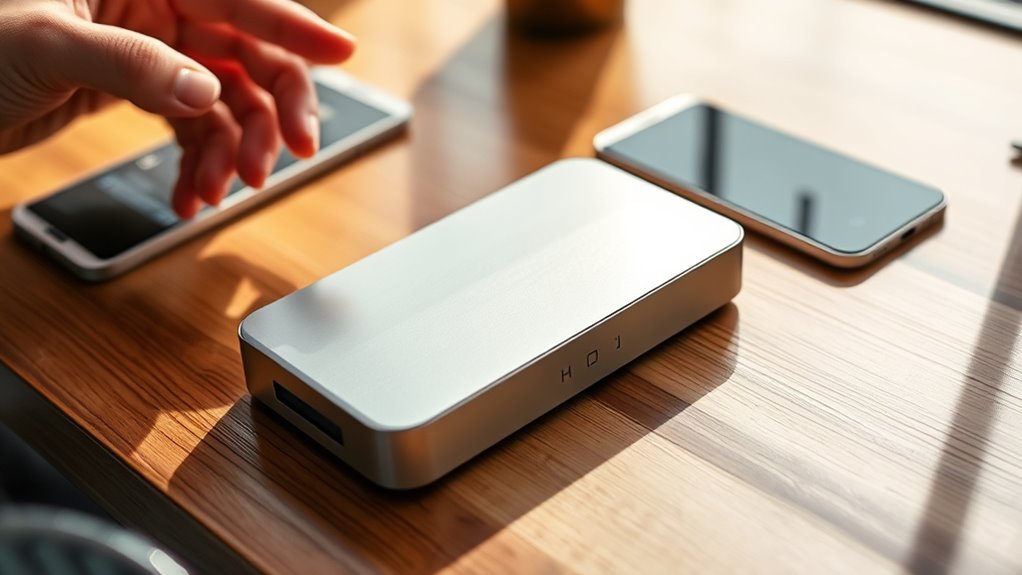
When selecting an NFC reader writer, I focus on compatibility with my devices and the types of cards it supports to guarantee seamless operation. I also consider data transfer speeds and security features to protect my information. Finally, I look for a model that’s easy to set up and use, saving me time and frustration.
Compatibility With Devices
Choosing an NFC reader/writer that seamlessly works with your device requires careful attention to compatibility factors. First, verify the device supports your operating system, whether it’s Windows, macOS, Linux, or Android, for smooth operation. Next, confirm that it complies with relevant standards like ISO 14443 or FeliCa to match your existing NFC tags and cards. Check the connection interface—USB Type-A, Type-C, or Bluetooth—to ensure it’s compatible with your hardware. Additionally, affirm that the firmware and software are compatible with your device’s specifications and environment. Lastly, consider whether the reader/writer supports the specific card types or protocols you plan to use, such as MIFARE or NFC Forum Tag types, to avoid future compatibility issues.
Supported Card Types
Selecting an NFC reader/writer that supports the specific card types you plan to use guarantees smooth operation and compatibility. I look for devices that support common options like MIFARE, Ultralight, FeliCa, or NFC Forum standards to ensure versatility. It’s also important to verify if the device handles multiple card frequencies, such as 13.56 MHz or 125 kHz, relevant to my applications. I double-check compatibility with protocols like ISO 14443A/B, ISO 18092, or ISO 15693 for reliable reading and writing. If I deal with sensitive data, I ensure the device can handle encrypted or secured cards. Additionally, I confirm whether it can read and write both contactless NFC tags and contact cards, depending on my needs. Supporting the correct card types prevents issues and maximizes functionality.
Data Transfer Speed
Faster data transfer speeds in NFC reader/writers mean quicker reading and writing, which can considerably boost your efficiency. With typical rates ranging from 106 kbps to 848 kbps, higher speeds enable real-time data exchange, especially useful in busy environments. The maximum speed depends on the NFC protocol and hardware capabilities, so choosing a device with robust specs can make a big difference. Devices supporting quicker transfer rates tend to have lower latency, making them ideal for secure transactions and contactless payments. If you handle large volumes of data or require frequent NFC interactions, prioritizing higher transfer speeds ensures smoother, more responsive performance. Ultimately, faster speeds lead to more seamless operations, saving time and reducing frustration during everyday contactless tasks.
Security Features Offered
Security features are vital considerations when evaluating NFC reader/writers, especially as faster data transfer speeds make transactions more efficient but also potentially more vulnerable. I look for devices with Secure Access Module (SAM) slots, enabling key diversification, mutual authentication, and encrypted transactions that enhance security. Support for industry standards like ISO 14443A/B, ISO 18092, and NFC Forum compliance guarantees secure communication between devices and cards. Anti-collision technology helps prevent unauthorized access and maintains reliable reading even in busy environments. Firmware upgradeability is fundamental for applying security patches and protocol updates, reducing vulnerabilities over time. Additionally, tamper detection and data encryption capabilities safeguard sensitive information from interception and unauthorized access, giving me confidence in the safety of my contactless transactions.
Ease of Setup
When choosing an NFC reader writer, ease of setup is essential to guarantee quick and hassle-free deployment. A plug-and-play device that requires minimal driver installation and configuration makes the process straightforward, saving time and frustration. Compatibility with popular operating systems like Windows, Linux, and macOS reduces technical barriers, ensuring smooth integration. Clear, detailed manuals or online guides help users install and start using the device confidently. Built-in features such as auto-detection of card types and automatic mode selection further streamline setup. Additionally, user-friendly software interfaces or mobile app support make programming and troubleshooting accessible, especially for beginners. Prioritizing these factors ensures you can start working with your NFC reader writer swiftly, without unnecessary complications.
Frequently Asked Questions
What Are the Compatibility Requirements for Different NFC Reader Models?
Compatibility requirements for different NFC reader models typically include supporting specific NFC standards like ISO 14443 or ISO 15693, guaranteeing the device is compatible with your operating system, and having the necessary drivers or software installed. I always check if the reader supports the tag types I need and verify connectivity options such as USB, Bluetooth, or NFC. This way, I ensure seamless integration with my devices and use cases without hassle.
How Secure Are Data Transfers With Various NFC Readers?
Think of NFC data transfers like passing a secret note — when using reputable readers, your info stays pretty well-guarded. Most modern NFC devices employ encryption and secure protocols, making eavesdropping tough. Still, I recommend sticking to trusted brands and keeping firmware updated. While no system is entirely foolproof, choosing well-designed NFC readers substantially boosts your security, giving you peace of mind during contactless transactions.
Can These NFC Devices Read Multiple Tag Types Simultaneously?
Yes, many modern NFC devices can read multiple tag types simultaneously. I’ve found that devices supporting multi-tag reading make my tasks much easier, especially in environments where different tag formats are used. These readers can quickly scan and process various tags like NFC, RFID, or different standards within seconds. It’s a huge time-saver and improves efficiency, especially when managing diverse contactless systems or inventories.
What Is the Typical Durability and Lifespan of NFC Reader Hardware?
Imagine using an NFC reader daily at a retail store. Typically, these devices last about 3 to 5 years with proper care. For example, a well-maintained professional-grade reader like the ACR122U can withstand thousands of scan cycles before showing wear. Regular cleaning and avoiding harsh environments extend their lifespan. So, durability varies, but quality units generally provide reliable service for several years with minimal issues.
Are There Any Legal Restrictions on Duplicating NFC Cards?
Yes, there are legal restrictions on duplicating NFC cards. I advise you to check local laws, as copying NFC cards without permission can be illegal, especially for access control, payments, or secure data. Always verify you have authorization from the card owner or the issuing authority. Unauthorized duplication can lead to legal consequences, so I recommend using NFC technology responsibly and within the bounds of the law.
Conclusion
Choosing the right NFC reader writer isn’t just about features; it’s about blending efficiency with reliability. While sleek designs and advanced capabilities catch the eye, I find that true value lies in seamless performance and ease of use. In a world where contactless tech is evolving rapidly, balancing innovation with simplicity becomes essential. After all, the best device isn’t just smart; it’s intuitive—making your contactless needs effortless, even in a complex digital landscape.
